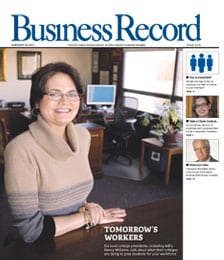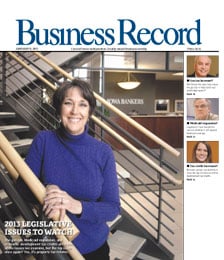Do Central Iowa residents need more fiber?

When Opportunity Iowa unveiled its proposal to move Iowa forward with fiber-optic connections to every home and business, one community at a time, it listed Indianola as one of about 20 cities that have a functioning fiber utility.
Well, sort of.
It’s “not much at this point,” said Mark Ramthun, general manager of Indianola Municipal Utilities, whose board approved the formation of a fiber communications utility seven years ago.
“We had big plans initially when we approved installing a fiber backbone installed to the house to compete with private vendors,” he said. Though a feasibility study indicated the publicly-owned utility would be able to cover the cost of installing fiber, “when we went out for bids they came out much higher than we expected them to be, so the board tabled it at that point,” Ramthun said.
IMU did install the fiber backbone that would have been part of the larger package. It connects the utility with each city and county building, as well as the schools and Simpson College, and the utility’s board continually revisits the feasibility of extending the fiber network, he said.
Within the past decade, a small number of Iowa communities have moved forward — with varying degrees of success — in providing fiber as an alternative to copper-wire connections to provide faster data and communication speeds to homes and businesses.
Opportunity Iowa, an effort spearheaded by telecommunications entrepreneur Clark McLeod, is pushing for communities to organize referendums in November 2005 to form “communications utilities.” Once the utilities are formed, cities could investigate the feasibility of installing fiber optic lines to each business and home in the community.
“Our goal, ultimately, is to make the state of Iowa, and the communities within the state, the most connected communities within the United States,” McLeod said.
However, Richard Vohs, president and CEO of Iowa Network Services, a private fiber network that connects 150 rural telephone companies serving small towns throughout Iowa, said communities must carefully weigh the risks, including the possibility that they could end up with a stranded investment if wireless or satellite technologies overtake fiber.
“I think generally it is not a good idea for government to get involved in business,” Vohs said. “Many such systems have not worked out well, costing citizens dollars and chasing away private dollars when they don’t work.”
The state’s earliest provider of municipal fiber has also been its most successful. Cedar Falls Utilities, which 10 years ago became one of the first municipal utilities in the country to provide direct fiber connections within a community, is now “far and away the predominant provider” of cable and data services in the city, said Jim Krieg, the utility’s general manager.
“In the early to mid-90s, we saw the need for having the technology, the high-speed Internet, to have it available to the homes,” Krieg said. “We didn’t see any private entity saying, ‘We will have it in your homes by this date.’ That was the issue that drove the board of trustees to really take control of their own destiny and say, if we’re going to get it done, we need to do it ourselves.”
In Central Iowa, Windsor Heights is one of nine communities that have expressed interest in moving toward a fiber utility referendum through Opportunity Iowa, along with Altoona, Carlisle, Johnston, Marshalltown, Nevada, Norwalk, Polk City and Winterset.
“At this point, we’re just investigating putting it on the ballot,” said Marketa George Oliver, Windsor Heights’ city administrator. The city recently extended a fiber optic line to city hall through a 28E intergovernmental agreement with the West Des Moines Community School District.
Though there’s no perception of a bottleneck in service in Windsor Heights right now, “I think it’s a matter of preparing for the future,” she said. “I think the council felt that they should continue to explore the idea in planning for the future.”
When considering the requirements of a fiber network, everyone’s needs are different, Vohs said.
“There are some people who are only interested in getting phone service; other people want lots of information, multiple video channels and high-speed Internet,” he said. “The challenge in this business is designing a system that meets most people’s needs, without being overpriced.”
McLEOD: FIBER EQUALS JOBS
Greater fiber connectivity in Iowa will equate to more jobs for the state in the future, says
Clark McLeod, former CEO of McLeodUSA and founder of OpportunityIowa.
“It’s important to communities within the state, because we’re moving into an information age, and many of our new jobs, and certainly many of our new jobs 10 years from now, will be dependent on communications utilities,” he said. “And second, as a citizen and a person who lives in this state, you want to enjoy the best possible communications services you can, and at the lowest possible price.”
In January, McLeod formed Fiberutilities of Iowa, a professional management company to assist communities in establishing fiber utilities. Since April, the non-profit Opportunity Iowa has engaged 83 communities in 55 counties to consider moving forward to a referendum vote next November. Currently, 50 Iowa cities have created a municipal communications utility.







